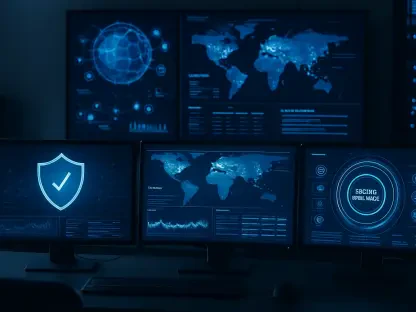Containerization has rapidly revolutionized the landscape of software development and deployment, introducing a method that packages applications with all their dependencies for seamless operation across different computing environments. As we delve into 2024, it’s crucial to understand the intricacies of containerization, especially its impact on security and deployment.
The Upsides of Containerization
Enhanced Variety in Technologies
In recent years, an expanded spectrum of container technologies has emerged, offering IT teams various tools tailored to specific needs. Docker, the most popular open-source container runtime, is widely utilized, while other options like Linux containers (LXC) and Windows containers cater to different environments. Tools such as Kubernetes are also essential for managing container orchestration efficiently.
These advancements provide a comprehensive toolbox for IT professionals, allowing them to choose the best technology based on their unique requirements. Docker’s ease of use and integration with numerous platforms have made it a go-to option for many organizations, while LXC offers a more lightweight and flexible approach for those looking to leverage existing Linux environments. By incorporating these diverse technologies into their workflows, IT teams can ensure greater flexibility and efficiency in their operations.
Furthermore, the array of orchestration tools available to manage these containers cannot be overstated. Kubernetes, arguably the most prominent orchestration platform, has set the standard in automating the deployment, scaling, and management of containerized applications. As organizations continue to adopt these technologies, the ecosystem’s maturity and robustness enable them to tackle complex deployment scenarios effectively, thus fostering innovation and agility.
System Isolation and Security Advantages
One of the most significant benefits of containerization is the isolation it provides between the user space and the host environment. This setup ensures optimal resource management and enhances security by isolating processes within the container, preventing breaches from affecting the host system. Containers come with their own filesystem, networking, and process space, which means that the processes running inside a container are separated from those on the host system.
This isolation not only improves the efficiency of resource allocation but also serves as a robust security measure. In the event of a security breach within a container, the attack is contained, and the host system remains unaffected. For instance, if a web server within the container is compromised, the attacker would not have direct access to the host’s resources, thereby significantly reducing the potential damage. This aspect of containerization is particularly crucial in today’s cybersecurity landscape, where threats are becoming increasingly sophisticated.
Moreover, system isolation plays a vital role in maintaining the stability of the host environment. Since containers are isolated, they can run different versions of software or even different operating systems without causing conflicts. This reduces the likelihood of dependencies clashing and ensures that the host system remains stable and secure. These qualities make containerization an attractive option for organizations looking to enhance their security posture while efficiently managing their computing resources.
Stability and Efficiency
Immutability for Security Purposes
The immutable nature of containers is crucial for security. Once a container image is deployed, it cannot be changed without rebuilding it. This characteristic helps in thwarting persistent threats, as any compromise is eliminated once the container is removed and recreated.
Having immutable container images means that the deployed application’s environment remains consistent throughout its lifecycle. When a container image is created, it encapsulates all necessary dependencies, configurations, and runtime libraries. This encapsulation ensures that every time the container is deployed, it operates in a known and trusted state. Consequently, if a container is compromised, any malicious changes made by an attacker would be discarded upon redeployment, reinstating the original secure state of the container.
The practice of using immutable containers is not only a security measure but also a mechanism for maintaining operational consistency. Immutable containers eliminate the “it works on my machine” problem, as every deployment is identical to the tested and validated environment. This significantly reduces the risk of unexpected issues arising from environmental discrepancies, thereby streamlining the deployment pipeline and fostering greater reliability in operations. Organizations that adopt immutable containers can enjoy enhanced security alongside operational stability.
Facilitating Development and Production
Containerization simplifies continuous integration and continuous delivery (CI/CD) processes. Developers can push code changes that trigger automated re-deployment pipelines, reducing bugs and ensuring smoother production deployments. This efficiency contrasts with the error-prone traditional deployment methods.
In traditional deployment scenarios, coordinating environments between development, testing, and production stages often involves time-consuming configuration management and manual intervention. Containerization, however, encapsulates an application and its dependencies into a standardized unit, making it easier to deploy across different stages of the software lifecycle. This leads to an accelerated development process, where new features and updates can be integrated and deployed more quickly.
Moreover, automated pipelines enabled by containerization facilitate ongoing testing and validation of code changes. When developers push new code commits, these automated systems can build, test, and deploy the containerized application seamlessly, ensuring that any issues are identified and addressed early in the development cycle. This approach not only minimizes disruptions during production deployments but also enhances the overall quality and reliability of software releases. By leveraging containerization within CI/CD workflows, organizations can achieve rapid and secure deployment, thus driving greater agility and innovation.
Addressing the Downsides
Managing Large-Scale Environments
Despite its advantages, containerization involves complexities in managing vast container ecosystems. The rapid evolution of technologies demands advanced skills and sophisticated tools to address challenges related to compatibility, security vulnerabilities, and misconfigurations.
Managing a large-scale containerized environment is no small feat. It requires a meticulous understanding of various container technologies and orchestration tools, as well as the ability to address compatibility issues that arise from the fast-paced evolution of these technologies. As organizations scale their container infrastructure, they must deal with intricate dependencies and integration challenges that can introduce significant technical debt if not handled properly.
Security remains a pervasive concern in large-scale environments. The sheer number of containers and their interdependencies can create numerous attack surfaces. To mitigate these risks, organizations must employ robust security practices, such as regular vulnerability scanning, runtime protection, and adherence to security policies throughout the development and deployment lifecycle. Additionally, container orchestration platforms like Kubernetes provide features that help manage these environments effectively, such as role-based access control (RBAC) and network policies. However, these features require careful configuration and ongoing management to ensure that they are effective in maintaining security.
Kernel Vulnerabilities and Maintenance
Containers share the host system’s kernel, which means any kernel-level vulnerabilities can impact all containers running on that host. It is imperative to keep the host system and containers up-to-date to mitigate these risks, a challenge not faced with virtual machines that have their own kernels.
The reliance on a shared kernel introduces unique security challenges for containerized environments. Since all containers running on a host utilize the same kernel, a vulnerability in the host’s kernel can potentially compromise all containers. This is a critical distinction from virtual machines, where each VM operates with its own isolated kernel, offering an additional layer of protection against such vulnerabilities.
Maintaining security in containerized environments necessitates vigilant monitoring and regular updates of both the host and container images. Administrators must stay abreast of security advisories and apply patches promptly to mitigate exposure to known vulnerabilities. This ongoing maintenance can be resource-intensive, requiring continuous effort and advanced expertise. Tools that automate patch management and vulnerability scanning can aid in this process, but the foundational responsibility of maintaining secure, up-to-date systems remains critical to safeguarding container deployments.
Ensuring Security and Avoiding Pitfalls
Verifying Software Sources
Using public container images requires rigorous verification to ensure they are free from malicious content. IT professionals must employ security scanning tools or build and host their own images, leveraging automated scans and original instruction files to maintain the integrity of container deployments.
Public container registries, while convenient, pose significant security risks if not adequately vetted. Malicious actors can exploit these platforms to distribute compromised images, which can inadvertently be pulled into an organization’s environment. To mitigate this risk, IT teams need stringent policies and tools to ensure only trusted images are used. Security scanning tools, such as those offered by Docker or third-party vendors, analyze container images for vulnerabilities and harmful content, providing an additional layer of security.
Furthermore, organizations can enhance security by building their own container images from verified source code and dependencies. This approach allows for greater control over the software supply chain, ensuring that every component within a container image is vetted and trusted. By maintaining their private image registries, organizations can systematically enforce compliance and integrity, leveraging automated scans and original instruction files to detect and resolve potential security issues before deployment. This practice, though requiring more resources, significantly bolsters the security posture of containerized environments.
Avoiding Misconfigurations
Containerization has swiftly transformed the realm of software development and deployment. This innovative approach encapsulates applications along with all their dependencies, ensuring smooth functioning across diverse computing environments. As we move into 2024, it’s essential to grasp the nuances of containerization, particularly its influence on security and deployment practices.
Historically, application deployment faced numerous challenges related to inconsistencies between development and production environments. Containerization addresses these issues by creating isolated, standardized units that run uniformly regardless of where they are deployed. This consistency significantly streamlines the development process, improving efficiency and reducing errors.
However, while containerization offers substantial benefits, it also introduces new security concerns. Each container can potentially become an attack surface, requiring stringent security measures to mitigate risks.
In summary, as we embrace 2024, understanding the multifaceted effects of containerization on software security and deployment is vital for leveraging its full potential while safeguarding against emerging threats.









